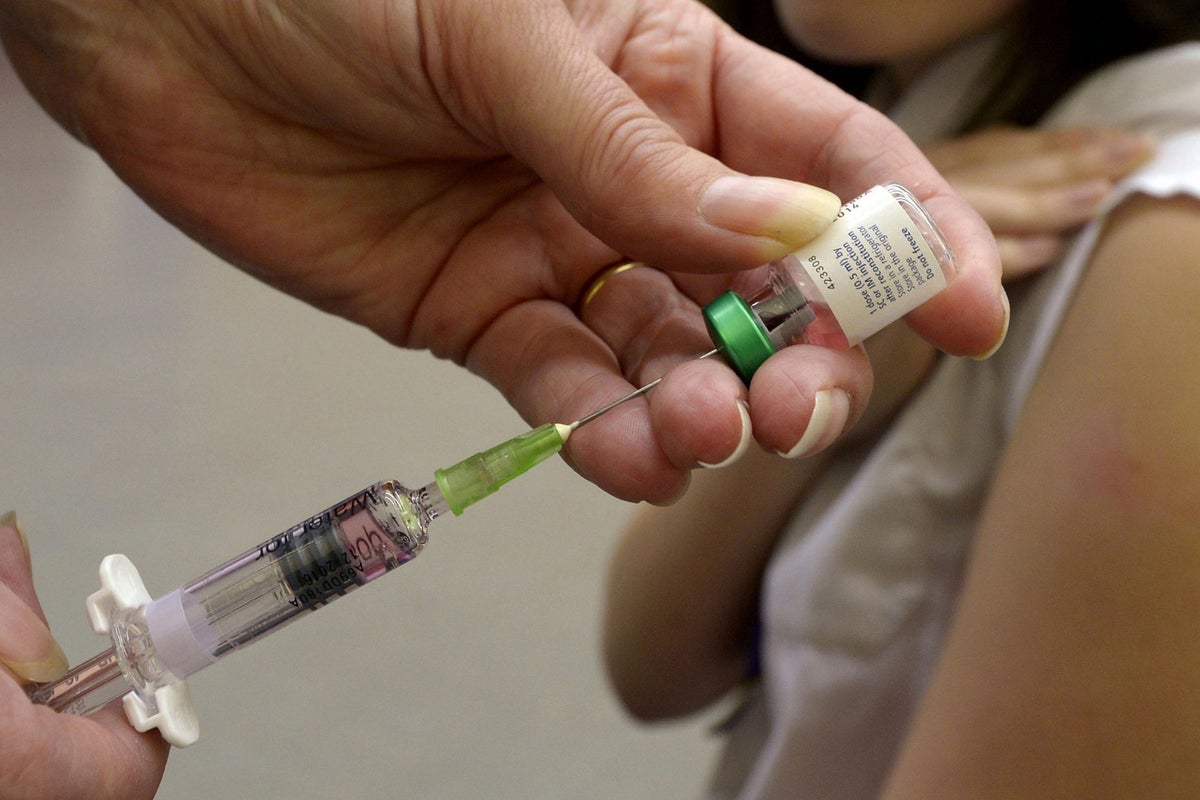
England is facing a measles emergency, with 86 cases confirmed in the past week and two-thirds of those affected aged 10 or under.
It has said the outbreak has now spread to every region in the country, having originated in the West Midlands, and the rate is at its highest since the 1990s.
Parents of a five-month-old baby who contracted measles said the experience of watching her suffer was “scary”.
Mother to Margot, Georgia House, told Sky News: “It’s really scary because I was holding my little baby, she was struggling to breathe and she looked god-awful.
“She had rashes on her tummy, behind her neck and going up her head.”
Dr Vanessa Saliba, a consultant epidemiologist at the UKHSA, said: “Numbers of measles cases are rising across the country, with a particular increase seen in London in recent weeks.
“Parents should check their child’s Red Book now to ensure that children are up to date with the MMR and other routine vaccines. If you’re unsure, contact your GP practice to check.”
So what is measles and what are the symptoms?
The World Health Organization says measles is a highly contagious – and sometimes fatal – disease which remains an “important cause of death among young children”. It is a viral illness of the respiratory system that, if left untreated, can have serious health complications, including infection of the lungs and brain.
The disease can spread through contact with infected mucus and saliva.
What are the symptoms of measles?
The NHS says the initial symptoms of measles typically develop about 10 days after the person is infected.
-
cold-like symptoms, such as a runny nose, sneezing and a cough
-
sore, red eyes that may be sensitive to light
-
a high temperature, which may reach around 40°C
-
small, greyish-white spots on the inside of cheeks
A few days later, a red-brown blotchy rash will appear, usually starting on the head or the upper neck before spreading to the rest of the body.
How do you spot a measles rash?
A rash will usually appear after the first few days of feeling ill.
The NHS identifies four key characteristics of a measles rash:
-
it is made up of small red-brown, flat, or slightly raised spots that may join together into larger blotchy patches
-
it usually first appears on the head or neck before spreading downwards to the rest of the body
-
it is slightly itchy for some
-
it can look similar to other childhood conditions, such as slapped-cheek syndrome, roseola, or rubella.
Measles will usually pass in around seven to 10 days but, in some cases, it can lead to potentially life-threatening complications.
These include meningitis, febrile convulsions, liver infection (hepatitis), pneumonia, and encephalitis (infection of the brain).
Can you get measles more than once?
Once you’ve developed immunity after vaccination or suffered from measles once, your body builds up a tolerance and it is unlikely you’ll get measles again.
Who is most at risk of developing measles?
Unvaccinated children are most at risk of developing measles and contracting its subsequent complications. Pregnant women are also at risk.
Any non-immune person (who has not been vaccinated or was vaccinated but did not develop immunity) can become infected by the virus.
How can you prevent measles?
Routine measles vaccinations for children have been in use for the past 50 years.
In the UK, measles is prevented by giving the MMR vaccine. This is given in two doses as part of the NHS childhood vaccination programme.
How do you treat measles?
There is no specific antiviral treatment that exists for measles, but there are several measures you can take to help relieve your symptoms.
-
taking paracetamol or ibuprofen to soothe fever, aches and pains
-
staying hydrated by drinking plenty of water
-
keeping the curtains closed to reduce light sensitivity
-
using damp cotton wool to clean the eyes
-
taking time off work or school for at least four days when the rash first appears
WHO also recommends that children diagnosed with measles should receive two doses of vitamin A supplements to prevent the risk of eye damage.
Who should have the MMR vaccine?
The first dose of MMR vaccine is offered to all children at one year old. Children are given a second dose of MMR before they start school, usually at three years and four months.
There are certain circumstances where children should not have the MMR vaccination. There are more details on the NHS website.
Adults who missed out on the MMR vaccine as a baby and are therefore not immune can have the MMR vaccine on the NHS.
In the 1990s and 2000s, there was some controversy about whether the MMR vaccine might cause autism following a 1998 study by Dr Andrew Wakefield. This caused a dramatic drop in the number of children being vaccinated.
There was later found to be no evidence to link the MMR vaccine and autism.
While the MMR vaccine may not work for everyone and can cause side effects in some children, the vaccine is generally recognised as safe. However, deciding whether or not to get your child vaccinated is a personal choice, so make sure you speak to your GP who can best advise you.
In 2016, the WHO announced the UK had eliminated the disease because of the effectiveness of the vaccine.
When was the MMR vaccine introduced?
The MMR vaccine was introduced as a single-dose schedule in 1988 and a two-dose schedule in 1996 with the aim of eliminating measles and rubella from the UK population.
If you were born before that, you may have received the measles vaccine, which was introduced in the UK in 1968.
Since the MMR vaccine was introduced, the diseases have become rare in the UK.











